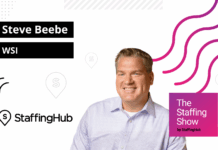
Key takeaways:
- Market stability enables strategy: Time-to-fill is leveling off, giving staffing agencies a more predictable 2026 where they can shift from crisis response to long-term investments in tech, talent, and market expansion.
- Hybrid, local, and sector-focused growth: Demand is rising for contract/fractional roles and local (non-relocation) talent, with strongest growth in manufacturing, construction, healthcare, tech, and supply chain.
- Tech-enabled, consultative agencies will win: AI is speeding up sourcing and matching but can’t replace strategic thinking.
Recent survey data from HireQuest’s network of 400+ staffing offices paints a picture of where the labor market is headed in 2026, helping staffing leaders plan their strategic initiatives for the year ahead.
After years of unprecedented volatility, the employment landscape appears to be entering a phase of equilibrium. The data suggests we’re moving into what could best be described as a “strategic reset,” neither boom nor bust, but a realignment of how work gets done and where value is created.
68% of offices report steady fill rates
HireQuest’s research shows a widespread expectation of market stability. This year, 68% of surveyed offices said time-to-fill for open roles stabilized and 35% experienced increases. And with 61% of recruiters anticipating steady time-to-fill metrics in 2026 and another 15% expecting improvements, it’s looking like staffing agencies will finally be able to move from reactive crisis management to proactive strategic planning.
For leaders focused on sustainable growth, this stability creates an environment where longer-term investments in technology, talent development, and market expansion can yield predictable returns. The days of dramatic month-to-month swings that made forecasting nearly impossible appear to be behind us.
However, stability doesn’t mean stagnation. The underlying dynamics of the labor market are shifting in ways that create distinct competitive advantages for agencies that can adapt quickly.
Contract and fractional roles surge
Perhaps no trend holds more strategic importance than the rise of fractional and contract-based work arrangements, which suggests there may be a more hybrid workforce restructuring ahead.
As the traditional boundaries between different staffing models dissolve, agencies that can offer integrated solutions will capture disproportionate market share. This may mean moving upmarket, offering sophisticated workforce solutions that blend permanent placement, contract staffing, and fractional services.
For technology leaders within staffing firms, this trend demands a hard look at your current tech stack. Can your systems handle the complexity of managing hybrid workforce models? Are your ATS and CRM platforms equipped to track candidates across multiple engagement types? The agencies that invest in flexible, integrated technology platforms now will have a significant operational advantage as this trend accelerates.
Workers choose local work over relocation
Although technology has made remote work more feasible than ever, workers are increasingly prioritizing local opportunities over relocation. For staffing agencies, this trend emphasizes deepening presence in key markets rather than spreading resources thinly across multiple geographies.
Your value proposition isn’t just about having candidates, but having the right candidates in the right locations. Agencies with strong local market knowledge and deep community connections will outperform those relying on broad, generic approaches. Consider how your marketing strategy can emphasize local expertise while maintaining the credibility that comes with broader market presence.
Manufacturing and healthcare lead growth
The research identifies clear winners in terms of sector growth: skilled manufacturing and construction roles, healthcare positions, technology specialists, and supply chain professionals. Conversely, administrative and routine office roles continue their decline as AI automation takes hold.
For agencies currently heavy in administrative staffing, this may require difficult conversations about strategic repositioning. The good news is that the stability of the overall market provides breathing room to execute these transitions thoughtfully rather than frantically.
AI speeds recruiting but can’t replace strategic thinking
The role of AI and automation in staffing operations can’t be ignored. HireQuest’s survey points to technology improving recruiting speed and match quality.
CTOs and technology leaders should think beyond simply automating existing processes. For example, how can AI help you identify candidates with transferable skills for clients struggling to find exact matches? Can predictive analytics help you anticipate client needs before they articulate them?
Employers want “unicorns” at pre-2020 rates
One concerning trend is the widening gap between employer expectations and market realities, particularly around compensation and candidate qualifications. Staffing agencies are uniquely positioned to bridge this gap, but doing so requires a more consultative approach.
This shift demands investment in your team’s capabilities. Account managers need to evolve from order-takers to strategic advisors who can have difficult conversations with clients about market conditions. Recruiters need skills in candidate coaching and development, not just sourcing. Marketing teams need to create thought leadership content that educates both clients and candidates about evolving market dynamics.
The chaos and unpredictability of recent years are giving way to a new normal characterized by hybrid workforce models, sectoral specialization, and technology-enabled service delivery. With market stability providing a window of opportunity, 2026 may well be remembered as the year that separated the industry’s future leaders from its legacy players.





